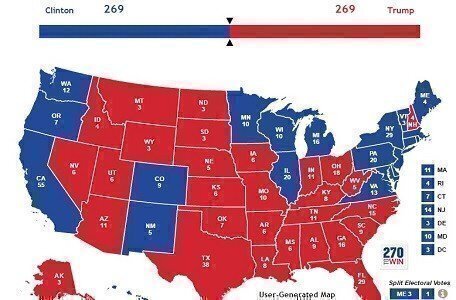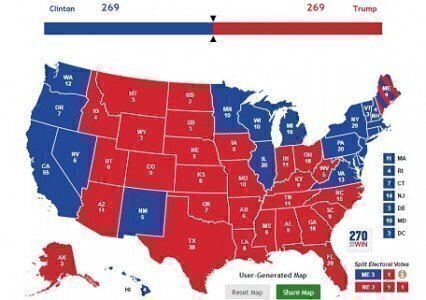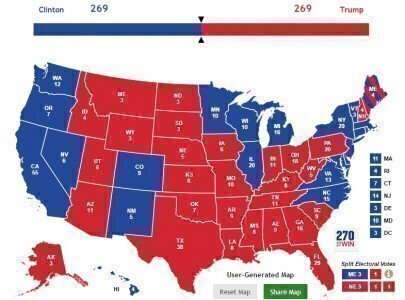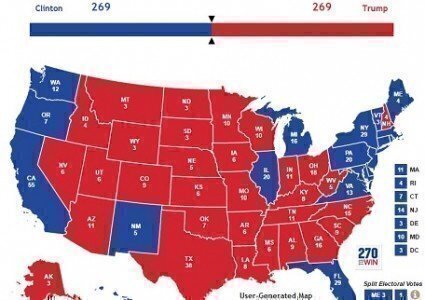As Hillary Clinton and Donald Trump head toward the presidential finish line on November 8, it’s time to revisit one of the most popular topics discussed on our blog: What happens if the Electoral College ties?
Back in 2012, we did several blog posts on this topic and they were the most-viewed topics of the presidential race season. So four years later, we’re taking another look at the tie scenarios and what could happen after November 8, 2016.
If you think a tie scenario is out of the question, there are two reasons why a tie or a contingent election is always a possibility. First, thanks to the 23rd Amendment, we currently have an even number of votes in the Electoral College; that makes a tie mathematically possible. And under the 12th Amendment, a tie election (or one without a candidate with a majority of Electoral votes) sends the presidential election to Congress to decide in a contingent election. A faithless elector or a third-party candidate can alter the math, in theory, to send an election to Congress.
This has happened twice in our history. In 1800, Thomas Jefferson and Aaron Burr tied in the Electoral College under the old system that gave each elector two votes for President. The 12th Amendment altered that system to allow for separate votes for President and Vice President. Since then, the only election not decided by the Electoral College was the 1824 contest, when Andrew Jackson led the college but didn’t have a majority of votes. In the contingent election, the House chose John Quincy Adams over Jackson.
What about 2016? Could there be a tie election between Clinton and Trump? To be sure, there are many combinations of states that could give each candidate 269 electoral votes. In all likelihood, the battleground or swing states would need balance out. But two states, Maine and Nebraska, allocate their electoral votes by congressional district, which complicates some of the scenarios.
For the sake of this discussion, the swing states in question are Colorado, Florida, Maine, Michigan, Minnesota, New Hampshire, Nevada, North Carolina, Ohio, Pennsylvania, and Wisconsin. (Other states, such as Iowa, Arizona, Virginia and Indiana, could also be a factor.)
Here is a look at a few tie-vote scenarios. We used the popular website www.270towin.com to generate the maps:
 1. Clinton loses New Hampshire, Trump takes Nevada
1. Clinton loses New Hampshire, Trump takes Nevada
In this scenario, Trump wins Florida, North Carolina, New Hampshire and Nevada (states where Clinton has led in polls) and retains Ohio.
Clinton would win Pennsylvania, Maine outright, Colorado and Midwestern states such as Michigan, Minnesota and Wisconsin.
That puts the election in a 269-269 tie.
2. Remember the Maine scenario.
 The state’s law says that of Maine’s four electoral votes, two go to the popular vote winner, and an electoral vote goes to winner of its two congressional districts. So the popular vote winner would get at least three of the four electoral votes in Maine.
The state’s law says that of Maine’s four electoral votes, two go to the popular vote winner, and an electoral vote goes to winner of its two congressional districts. So the popular vote winner would get at least three of the four electoral votes in Maine.
In this scenario, Trump just needs to get one electoral vote in Maine from its 2nd Congressional District. In addition to that one vote, Trump needs Florida, North Carolina, Ohio and Colorado to force the 269-269 tie. Clinton would retain Pennsylvania, Nevada and New Hampshire, along with Michigan, Minnesota and Wisconsin.
3. Pennsylvania, New Hampshire and Maine CD2 go to Trump.
 Another scenario shows what happens if the GOP takes the keystone state of Pennsylvania, and gets five electoral votes out of Maine and New Hampshire, while keeping Florida and Ohio.
Another scenario shows what happens if the GOP takes the keystone state of Pennsylvania, and gets five electoral votes out of Maine and New Hampshire, while keeping Florida and Ohio.
The Democrats could still take Colorado, Nevada, North Carolina, Michigan, Minnesota and Wisconsin, and wind up in a tie election.
In many other current scenarios, Pennsylvania plays out as a key state for the Republicans, and it may be needed along with Florida for a Trump victory, unless ...
4. Minnesota and Wisconsin go to the Republicans.
 In this scenario, the Democrats lose Minnesota, Wisconsin, and New Hampshire, while the Republicans hold onto Ohio, North Carolina, and one vote from Maine.
In this scenario, the Democrats lose Minnesota, Wisconsin, and New Hampshire, while the Republicans hold onto Ohio, North Carolina, and one vote from Maine.
That would put the Democrats in the odd scenario of winning Florida, Pennsylvania, Michigan, Colorado and Nevada – and coming up one vote short.
Another version of this scenario would have Pennsylvania (with 20 electoral votes) flipping places with Minnesota (10 electoral votes) and Wisconsin (10 electoral votes).
If the election does wind up in a tie, then it will be settled as a contingent election in Congress. The new House would decide the presidential contest, with each state delegation getting one vote. The new Senate settles the vice presidential race, with each Senator getting a vote.
Before that would happen, there could be efforts to contest the outcome in close states or the legitimacy of the electoral slates submitted from each state. In 1876, a conflict among electoral slates submitted by southern states led to a special committee composed on congressional members and Supreme Court Justices to decide the electors – and the election for Rutherford B. Hayes.
And in 2000, the Supreme Court had to step in to determine how the electoral slate outcome from Florida would be tallied in its Bush v. Gore decision.







